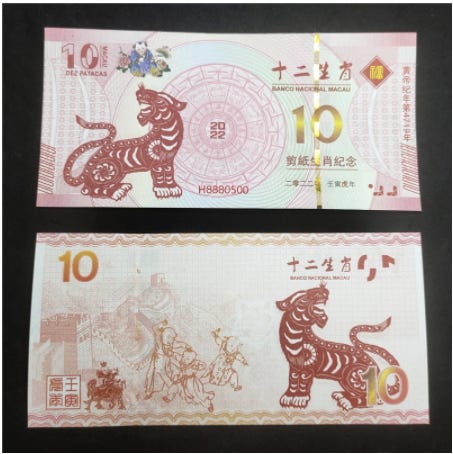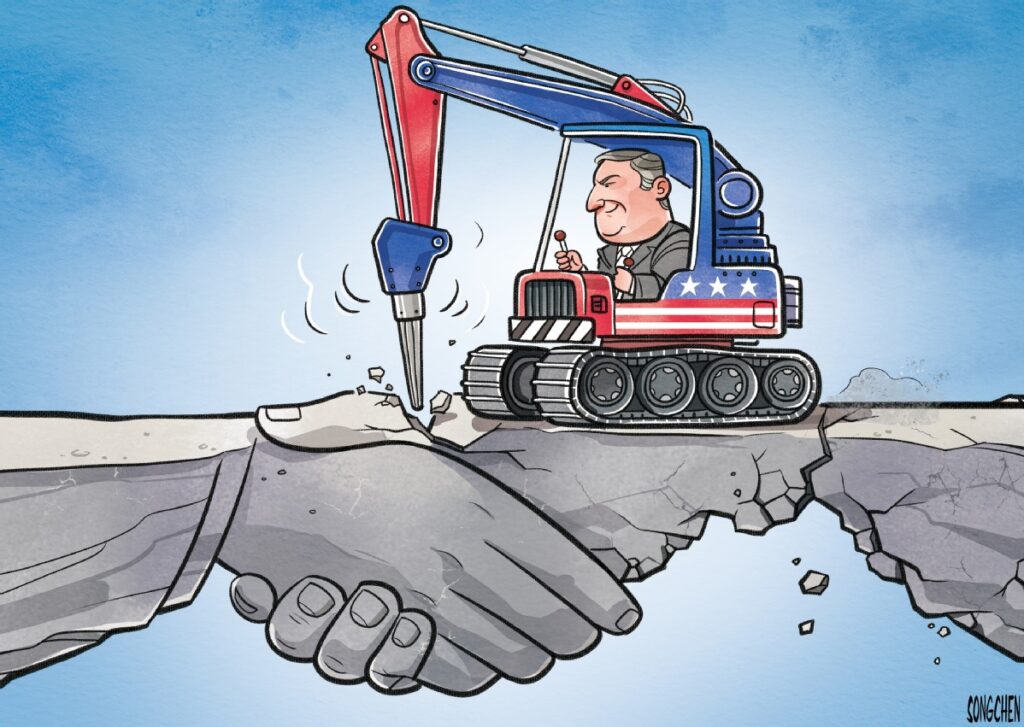Dear Reader,
In Mandarin, the term paper tiger (zhilaohu) refers to someone who seems very powerful and threatening, but is in fact ineffectual, due to his own incompetence.
As the Chinese Year of the Tiger dawns, we want to concisely lay out China’s macro and market position, based on where we’ve been, and make some predictions & recommendations based on that.

On the highest level, for China markets in the coming year, neither will you hear the tiger roar, nor will it be caught by the tail, if we can leave the cliches there.
Instead, it will be a year of modest, not spectacular growth, with plenty of the volatility that makes active investing in China a must, as our partner Qi Wang of MegaTrust Investments explains.*
On that same high level, we maintain that China is no paper tiger, much as the western mainstream narrative would have audiences believe. We’d go so far as to suggest that American monetary policy speaks much more to cheap paper. The takeaway: more than ever, China domestic equities provide an uncorrelated opportunity for long-term growth, and truly diversified portfolio construction.
Read on for a summary of where China is and where its markets look to be going, and may the Year of the Tiger bring you health, wealth, and happiness!
The Tirith Team
Macro Report
The Odd Decouple
The U.S. government has been working hard on climate change – creating a climate of moral shame for doing business in China, that is. Nevertheless, China has grabbed the number one spot for FDI, with $163 billion to the United States’ $134 billion in 2020, as well as top spot for the first half of 2021.
COVID played a key role, as did under-reported factors: dropping of shared IP requirements & reduction of many domestic trade barriers.

“It’s Only Business, Sonny”:
We believe that global businesses think quite differently, and more pragmatically about China, than their less balance-sheet-bound governments. China accounts for half of the global market for most products, and will become the world’s largest economy by 2028, five years ahead of schedule, slowing growth factored in*. Therefore, rather than being pieces on the geopolitical chessboard, multinationals plan to stay out of the headlines, and quietly localize more of their Chinese production, to escape ever-tightening controls
On Gandhi & Growing Markets:
This peaceful business resistance to political pressure extends into financial investment as well. Since 2017, foreign holdings of Chinese bonds have tripled to $560b, and equity inflows have set a new record as well – $66.5b as of last December, almost double the level of a year earlier.
And yet these numbers still constitute a small fraction of the total, with foreign investors holding:
- 5% of onshore Chinese equities, up from 0.5% in 2017
- 3.8% of China’s interbank bond market, up from 1.9% in 2017
- 10.3% of Chinese government bonds (CGBs), up from 5% in 2017
“Man Man Lai (Slow Slow Come)”:
For its part, the Chinese government is sticking to its time-honored tradition of making haste slowly. Its demonstrated commitment to financial opening is borne of necessity, yet as Premier Li Keqiang put it last July:
“We need to take a holistic approach in handling the relationship between financial openness and financial security, to better safeguard China’s economic and financial security.”
Translation: Capital, foreign or domestic, will go to funding the real economy, not to reckless financialization and excessive speculation.
FROM GROWER TO SHOWER
Slower Than Molasses in January:
China’s GDP growth outlook has gone from hare to tortoise, to tortoise that needs a few cups of coffee. It seems even meeting the 5% line in the sand for ’22 will be difficult. Of course, keep in mind that 5% growth in China’s $17 trillion economy is equal to adding the economy of Germany every three to four years.
Also, the slowdown is far from an unexpected, inevitable party-killer. China’s planners have not only accepted, but rather embraced slower GDP growth, from a policy standpoint.
Like a bodybuilder getting ready for the Olympia, China is through with bulking, and aiming for a balanced, quality physique. Tapering off the diminishing gains of real estate steroids, upgrading the core manufacturing muscles, and getting a nice green look take precedence over setting new GDP records.
You Didn’t Get the Memo?
We don’t make such an overextended metaphor lightly – or hypothetically. We simply refer to the quinquennial memo known as the Five-Year Plan. However much you don’ t agree with China’s plans or policies, you can never say you weren’t warned.
The 14th Five Year Plan emphasized high-level but specific goals for not just the economy, but people’s well-being, innovation, dual-circulation, and green development. Here is a great overview:

What a Drag
It’s very helpful that China is so public with its KPIs, and admirable that it does a good job of hitting its goals. But we’re the last ones to overlook the macro challenges standing between China and its goals. Our fund managers are even more obsessed with the uncontrollable. And unlike the western financial press, they’re never surprised by resulting CCP policy, and always have a strategy in place:
Zero To Won:
The pandemic will continue to hammer travel/tourism, and many consumer sectors. China is suddenly the only big player in the once global game of “Covid Free”. The official strategy is that some painful restrictions in the short to mid will translate to that most-prized of objectives: long-term stability.

Flying in the Face of Logistics:
Won’t someone think of the poor Chinese manufacturers? The popular view of China’s role in the global supply chain crunch is as a port-clogging fusspot, even though it’s sending out some 300 million international parcels per day, according to our partner MegaTrust Investments‘ Charlie Chen. He foresees quite a bit of disruption for Chinese manufacturers themselves, although a lesser degree of increased cost passed on to the consumer as in other countries, depending greatly on the whims of ….
The Ignited Rates of America:
It would be nice for bankers representing 4% of the world’s population to keep printing dollars ad infinitum, passing the inflation effects on to emerging countries and its own have-nots. Great for the continued super-beta performance of the S&P 500, too.
Flying in the Face of Logistics:
Won’t someone think of the poor Chinese manufacturers? The popular view of China’s role in the global supply chain crunch is as a port-clogging fusspot, even though it’s sending out some 300 million international parcels per day, according to our partner MegaTrust Investments‘ Charlie Chen. He foresees quite a bit of disruption for Chinese manufacturers themselves, although a lesser degree of increased cost passed on to the consumer as in other countries, depending greatly on the whims of ….
The Ignited Rates of America:
It would be nice for bankers representing 4% of the world’s population to keep printing dollars ad infinitum, passing the inflation effects on to emerging countries and its own have-nots. Great for the continued super-beta performance of the S&P 500, too.
Market Report:
Who You Calling a Chinese Stock?
It’s key to remember that China’s A-Shares comprise well over 4,000 companies, with newer exchanges gearing up to introduce many more, and the government doing all it can to reform and streamline the IPO process. Then again, doing all it can to prevent exploitation of relaxed processes by an ever-ready horde of bad-faith actors is also a government priority. Did we mention “man man lai”? You hear that a lot in China. It means, “Don’t rush it, dude.”
So we’re cheered by reports that JP Morgan is calling “Chinese stocks” undervalued, and giants such as UBS and BlackRock are overweight “Chinese equities”. But to us, U.S. listed mega-cap VIEs like Alibaba and Tencent are about as Chinese as Jeremy Lin. China’s growth story will be told by its many domestic mid-caps, and the hundreds of small caps representing its New Economy.
A data point for early confirmation: the more mid-cap representative CSI 500 outperformed the CSI 300 by 21% last year.
Everything’s Relative:
According to aforementioned Tirith partner Qi Wang, of MegaTrust Investments, A-Shares are less correlated than ever to the NYSE, with S&P/CSI300 return correlation, averaging 44% from Q1 ’19- Q2 ’21, down to 16% in the second half of last year, and an S&P downside correlation of -43%.
So when the CSI 300 sank 2% a few days ago (Jan.27,’22), to its lowest level since September 2020, signalling a bear market, we couldn’t help but see the correlation with the Fed’s ultra-hawkish comments.
Thus, as we often do when in need of market insight, we turned to Qi Wang, who says:
“The China A-share market has been, and will continue to be de-coupling from the U.S. stock market. Statistically speaking, the weekly return correlation of the CSI 300 Index and S&P 500 has come down 10% since July 2021, versus a 3-year historical average of 43%. Fundamentally, China is a different (or even opposite) policy path from the U.S. The country is cutting interest rates and releasing more liquidity to the system, in a move to prevent economic hard-landing. There will be no excessive money printing, but China is definitely getting incrementally dovish with its monetary policy.
China has a “National Team” (its 10 biggest fund managers) which is ready to buy stocks directly and support the market if the situation calls. The U.S. does not have such a mechanism.
The near-term price movements suggest China A-shares has gone down with the U.S. Yet as of Jan 28, 2022, the CSI 300 Index is down “just 6.8% YTD while the S&P 500 is down 9.2% and the Nasdaq is down 14.5%. One month is a relatively short period of time. Over time (next 6-12 months) we are confident that China A-shares will be more resilient and trade differently from the rest of the world.”
Variations on Three Themes:
For comprehensive China financial research, you can’t beat CICC. So when their policy analysts lift their heads from piles of paperwork with a recommendation, it generally pays to listen. The tailwind structural trends to watch, per government soft decree, are industrial upgrade, consumption upgrade, and a shift from asset to financial allocation.
Thus they recommend exposure to:
- High-quality manufacturers, including auto parts, medical equipment and the new energy automobile industry chain.
- Consumer electronics, household appliances, beverages and dining sectors (not even Covid can keep Chinese from eating out, and now that per capital GDP has hit $10,000, we see brands that stress quality over quantity winning out, and not just in the restaurant industry. )
Despite our preceding poo-pooing of China’s large caps, we’d be remiss not to mention that our partners GuoTaiJunAn, also China research wizards, predict that large cap value stocks will outperform this year.
It Can’t All Be Wine And Roses:
According to Beijing’s Central Economic Work Conference held last December 2021, government policies will be more accommodative this year, which is good news in general for Chinese equities.
Having said that,
The ongoing debt woes of giant property developers, and the local governments which depended on them;
The western war on inflation, with rate hikes the only weapon left;
Geopolitical tensions and their tendency to make markets volatile;
Will all factor against the stable, steady, orderly growth of China’s domestic markets. So we predict that volatility will continue in 2022, and therefore must reiterate that an active approach, stock-picking with China’s most experienced fund managers is the preferred strategy for A-shares exposure.
In Other Words:






